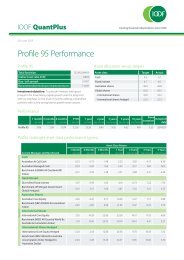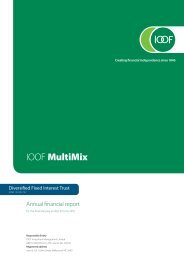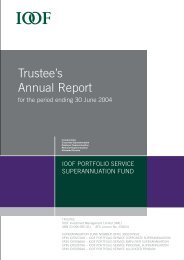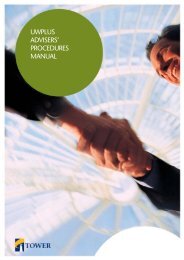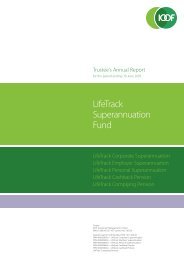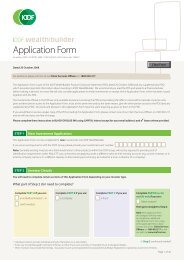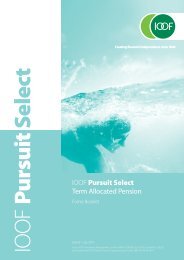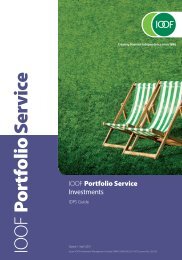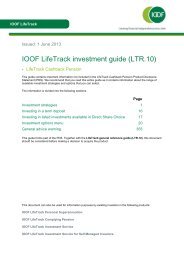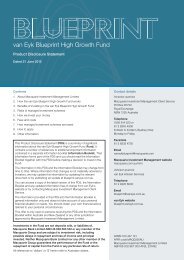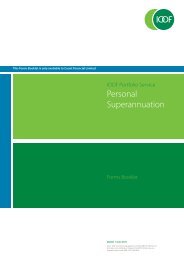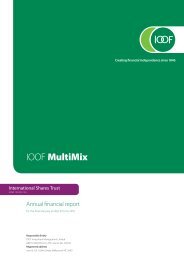annual report 2011
annual report 2011
annual report 2011
Create successful ePaper yourself
Turn your PDF publications into a flip-book with our unique Google optimized e-Paper software.
IOOF | <strong>annual</strong> <strong>report</strong> <strong>2011</strong><br />
(d) Contribution to profit or loss of life insurance business<br />
Statutory<br />
<strong>2011</strong> 2010<br />
$’000 $’000<br />
Revenue<br />
Interest income 1,009 818<br />
Dividends and distributions received 34,396 22,286<br />
Net fair value gains/(losses) on other financial assets at fair value through profit or loss 24,342 64,451<br />
Contributions received - investment contracts with DPF 13,563 13,577<br />
DPF policy holder liability increase 19,725 19,151<br />
Non - DPF policyholder liability decrease (13,021) (54,855)<br />
Other fee revenue 5,246 5,254<br />
85,260 70,682<br />
(e) Expenses<br />
Service and marketing fees expense 14,751 14,377<br />
Life insurance operating expenses 127 444<br />
Investment contracts with DPF:<br />
Benefits and withdrawals paid 49,017 51,979<br />
Termination bonuses 245 224<br />
Distribution to policyholders 7,146 6,258<br />
Interest 363 539<br />
71,649 73,821<br />
(f)<br />
Actuarial assumptions and methods<br />
The effective date of the actuarial <strong>report</strong> on the policy liabilities<br />
and solvency reserves is 30 June <strong>2011</strong>. The actuarial <strong>report</strong> for<br />
IOOF Ltd was prepared by Mr Kent Griffin, FIAA, and was dated<br />
23 August <strong>2011</strong>. The actuarial <strong>report</strong> indicates that Mr Griffin is<br />
satisfied as to the accuracy of the data upon which the policy<br />
liabilities have been determined.<br />
Actuarial Methods<br />
Policy liabilities have been calculated in accordance with<br />
relevant actuarial guidance issued by the Australian Prudential<br />
Regulatory Authority under the Life Insurance Act 1995. Policy<br />
liabilities are based on a systematic release of planned margins<br />
as services are provided to policyholders and premiums are<br />
received.<br />
Processes used to select assumptions<br />
Mortality and Morbidity<br />
All mortality and morbidity risk is fully reinsured and the<br />
gross risk to the Group is low. The mortality and morbidity<br />
assumptions have been taken to be equal to the reinsurer’s<br />
mortality and morbidity assumptions.<br />
Other Assumptions<br />
In adopting the accumulation method to assess the policy<br />
liabilities, one material assumption is required. It is assumed<br />
that the future overall experience as to expense levels,<br />
surrender/lapse rates and discount rates will likely remain<br />
within a satisfactory range so that the policies produce future<br />
profits for the business. In which case, there is no need to set<br />
aside provisions, in addition to the accumulation amounts, for<br />
future losses (i.e. there is no loss recognition concerns for the<br />
business). This assumption has been adopted on the basis that,<br />
based on the current actual experience of the business, the<br />
policies are producing satisfactory profits for the business and<br />
there are no circumstances known that would indicate that the<br />
current position (i.e. general experience levels and ongoing<br />
profitability) will not continue into the future.<br />
Sensitivity analysis<br />
The policy liabilities are not sensitive to changes in variables<br />
within a moderate range. Increases in mortality and morbidity<br />
assumptions will result in an increase gross policy liabilities<br />
for IOOF Ltd, however as the mortality and morbidity risk is<br />
fully reinsured any change in these assumptions would be<br />
consistent with the reinsurer’s assumptions and the net change<br />
in policy liabilities would be nil.<br />
page 111



